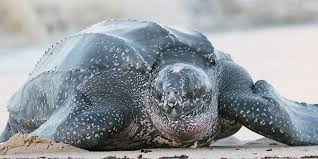UPSC Articles
Species in news: Leatherback Sea Turtle
Part of: GS Prelims and GS – III – Biodiversity; Environment
In news
- Some conservationists are worried about the fate of the Giant Leatherback turtles.
- NITI Aayog has laid down proposals for tourism and port development in the Andaman and Nicobar Islands.
Key takeaways
- NITI Aayog’s tourism vision includes a proposal for a mega-shipment port at Galathea Bay on Great Nicobar Island.
- Also, the Little Andaman plan proposes phased growth of tourism on this untouched island, which may lead to the de-reservation of over 200 sq km of rainforests and also of about 140 sq km of the Onge Tribal Reserve.
Important value additions
Leatherback sea turtle (Dermochelys coriacea)
- It is the largest of the seven species of sea turtles.
- Other species are: Olive Ridley turtle, Green turtle, Hawksbill turtle, Loggerhead turtle, Leatherback turtle
- Except the Loggerhead, the remaining four species nest along the Indian coast.
- It is found in all oceans except the Arctic and the Antarctic.
- Within the Indian Ocean, they nest only in Indonesia, Sri Lanka, and the Andaman and Nicobar Islands.
- It is the only living species in the genus Dermochelys and family Dermochelyidae.
- It can easily be differentiated from other modern sea turtles by its lack of a bony shell.
- They are listed in Schedule I of India’s Wildlife Protection Act, 1972.
Do you know?
- The Ministry of Environment has released National Marine Turtle Action Plan in which A&N Islands are given prominent importance.
- According to the plan, India has identified all its important sea turtle nesting habitats as ‘Important Coastal and Marine Biodiversity Areas’.
- These areas have been included in the Coastal Regulation Zone (CRZ) – 1.
- South Bay and West Bay on Little Andaman and Galathea on Great Nicobar, are mentioned as “Important Marine Turtle Habitats in India”
Related articles
- Mass nesting of Olive Ridleys: Click here















